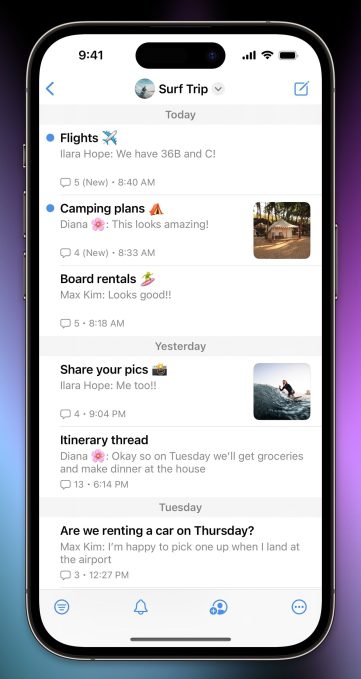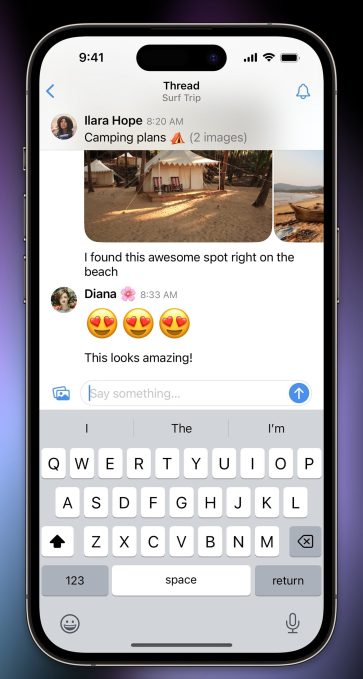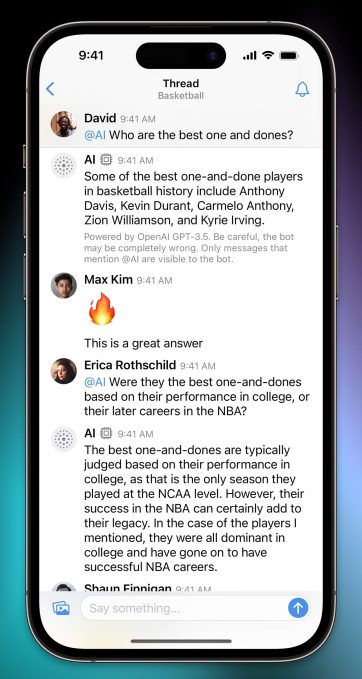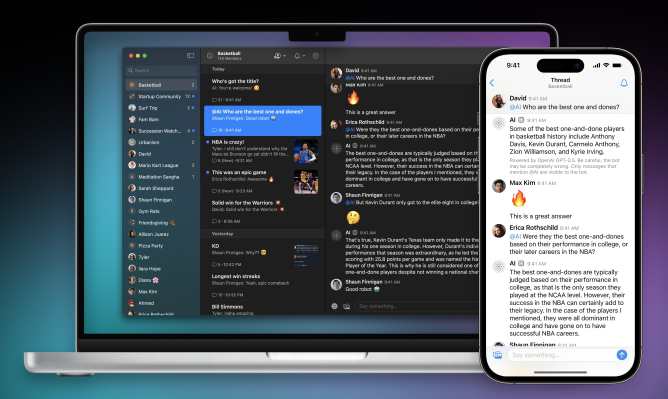There are billions of people using WhatsApp, Telegram, iMessage or even Instagram for group chats. These platforms are ideally designed for “personal conversations” — more specifically individual chats. A new app called Wavelength wants to change that narrative by putting group chat on the front stage.
The app is built by the makers of Telepath, a social network that debuted in 2020. But it never really took off as it was shut down last year.
At the core, Wavelength — currently available on iOS and Mac to everyone — wants to solve the mess of traditional groups by creating threads for different conversations. In a typical WhatsApp or Telegram group, the chat is one-dimensional. All participants are sending messages to one giant river. So people can be talking about sports, politics and movies at the same time. The user is on their own when it comes to finding out the context for each of these topics and which message belongs to which subject.
That’s why Wavelength puts an emphasis on threads. When you first start a group in the app, you also start the first thread when you type a message — even if the group just has two people. After that, other users can respond to that thread or create a new one.
By default, after signing up you will see “groups” with contacts that are already using the app (those are auto-generated one-to-one groups) and a GPT 3.5-powered bot — more on that later. You can join a group through a public link or a friend can add you to a group.

Image Credits: Wavelength
Users can simply get started by downloading the app and signing up with a phone number. But unless you already have some folks using the app, or have invites to some groups, starting out can be tough. There is no clear mechanism for group discoveries. You might have to hunt for groups on Twitter or Reddit, or ask folks you know to send you an invite or join you on the platform.
The lists of groups and conversations look like an email inbox with a blue dot next to a group or thread when there is a new message. When entering a group, you’ll see a preview of the latest message to each thread (just like an email inbox). This design philosophy was suggested by John Gruber, who is now an advisor to the company behind the app. Prior to this Wavelength used to show preview cards for threads.
The story behind Wavelength
The core team of Wavelength — CEO Richard Henry, CTO Riley Patterson and Chairman Marc Bodnick — talked to me in a group chat and explained how they came up with the idea of building the app. They said that Telepath wasn’t growing and the world was moving to private chats. So they shut down the social app in August 2022 and began working on Wavelength.

A thread in Wavelength chat. Image Credits: Wavelength
“I had been thinking about the idea of threaded private chat going back to when we first started working on Telepath. When it was just Marc and I using the very first Telepath prototype, we used it for all kinds of conversations — naming the product, hiring our first engineer, chatting about dinner, etc. I remember thinking this is awesome, it’s basically a threaded private messaging app,” Henry said.
“We considered just building private groups into Telepath as a feature, but we felt strongly that private chat needs strong end-to-end encryption, with messages stored on the device rather than in the cloud. So Wavelength needed to be a totally new product.”
The team said that in today’s group chat, you can talk about only one thing at a time. It noted that people often just mute group chats because they don’t want to get notified about every conversation. But you might miss out on interesting conversations because you either mute everything or nothing. Developers said that using threads was the obvious solution.
The startup released the closed beta of the product last summer and opened it up to a wider audience in March.
Privacy
For Wavelength, privacy is also a key feature. The app supports double ratchet end-to-end encryption for enhanced security. Users have to sign up on the app with a phone number, but the app doesn’t share it with anyone. Even when you join a group, the only thing you can see is the names of other members and not their contact details.

Wavelength has end-to-end encryption for all chats. Image Credits: Wavelength
When it comes to other apps that facilitate group chat, Telegram allows you to hide your phone number and display only your name or username. However, it’s important to remember that Telegram doesn’t have end-to-end encryption for group chats.
Wavelength has also worked out encryption for historical messages. When a new member joins the group the app re-encrypts and securely shares recent message history so they can catch up. This is unlike WhatsApp, where you will only see messages after you joined a group.
Integrating AI
One of the things that stands out in Wavelength is its integration with a GPT-3.5-powered bot. You can have conversations with the bot about different kinds of things. But you can also call the bot to ask a question within a group conversation.
This is helpful in a few ways. There’s the novelty factor of AI chatbots. With this feature, you don’t have to download a separate app or create an account on OpenAI just to try out an AI-powered bot. Plus, an AI bot can be useful in a group with your friends in a different way. For instance, you can ask for suggestions, such as recipes for a dinner party or a movie to watch on the weekend.

Image Credits: Wavelength
The Wavelength team said that originally they didn’t plan to make a friends and AI app. But given the thread system in the app, AI can be a perfect companion. Mind you, AI can’t summarize the whole conversation for you as it only knows about messages it posted. This is due to the privacy-focused design of the app, as Wavelength doesn’t share your conversation with OpenAI — the company behind GPT.
While the developers have found a unique way to tackle group messages, there are some challenges for the developers. As we mentioned above, group discovery is a huge friction point right now. Your friends won’t probably ditch WhatsApp or iMessage and switch to Wavelength. Moreover, a group app is only useful if your entire group of friends is using the app.
While the app has been designed for private, invite-only groups, Wavelength can also facilitate semi-open big groups as well. The Wavelength team mentioned the group of Dithering podcast subscribers with thousands of members as an example — Dithering is a show by Gruber and Ben Thompson. Currently, there is a 10,000-member limit on groups. While Telegram offers 200,000 member group chats, Wavelength’s limits are still significant.
There is also no thread search feature, which sometimes makes it difficult when you’re trying to look for older threads if several new threads have been created. That feature could also be used to look for an existing thread on the same topic.
Philosophically, Wavelength lies in between Twitter, Reddit, WhatsApp, Telegram, Discord and a good old discussion forum — all of which are trying to facilitate a conversation for a community or an interest group. It allows a group to chat with each other and breaks out the conversation into threads.
In comparison, WhatsApp and Telegram have a linear chat mechanism — though Telegram allows commenting/threading on a message. A Discord server usually has channels for different subjects or topics, but it’s a rigid structure that doesn’t change very often. Twitter users only get a single feed by default and can create additional lists — but those are rarely shared. Reddit has a structured feed of posts for each subreddit with a conversation thread under each post.
“Slack threads drive me crazy — the conversation usually starts in the channel, then someone spins it off into a thread, and then you’ve lost the first part of the conversation. So we wanted to build really intuitive threading, where you can’t screw it up,” Henry said.
Wavelength is in the early stage of its lifespan. It doesn’t have feature parity with the likes of WhatsApp or Telegram. For instance, it doesn’t support reactions, GIFs or group calls. But the team is working on bringing some of those things. At the moment, there can only be one admin per group, which is fine for a group with a limited number of members but can be limiting for larger groups.
The company is working on a few things at the moment: One of them is moderator tools like multi-admin for groups, thread pinning and the ability to define group rules. Plus, there is an Android version in the works, as the team said multiple people want to make groups with their friends regardless of what device they use.
The Wavelength team added that it also has a roadmap with tons of AI features, but didn’t give any details.
As for the business model, the company said it wants to keep Wavelength free for individual users. “We’ll never do ads — in addition to being terrible for privacy, they don’t work well in a messaging app anyway,” it said. To earn money, Wavelength plans to offer a pro version with more features along with a Wavelength for organizations that will be an alternative to something like Slack. But the team admits there is a long way to go before they can compete with the Salesforce-owned tool.
